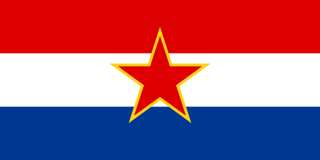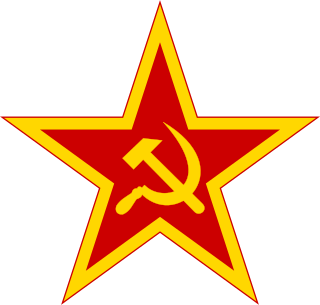
Yugoslavia was a country in Southeast and Central Europe for most of the 20th century. It came into existence in 1918 following World War I, under the name of the Kingdom of Serbs, Croats and Slovenes from the merger of Kingdom of Serbia with the provisional State of Slovenes, Croats and Serbs, and constituted the first union of the South Slavic people as a sovereign state, following centuries in which the region had been part of the Ottoman Empire and Austria-Hungary. Peter I of Serbia was its first sovereign. The kingdom gained international recognition on 13 July 1922 at the Conference of Ambassadors in Paris. The official name of the state was changed to Kingdom of Yugoslavia on 3 October 1929.

Franjo Tuđman, also written as Franjo Tudjman, was a Croatian politician and historian. Following the country's independence from Yugoslavia, he became the first president of Croatia and served as president from 1990 until his death in 1999. He was the ninth and last President of the Presidency of SR Croatia from May to July 1990.

The Croatian Spring, or Maspok, was a political conflict that took place from 1967 to 1971 in the Socialist Republic of Croatia, at the time part of the Socialist Federal Republic of Yugoslavia. As one of six republics comprising Yugoslavia at the time, Croatia was ruled by the League of Communists of Croatia (SKH), nominally independent from the League of Communists of Yugoslavia (SKJ), led by President Josip Broz Tito. The 1960s in Yugoslavia were marked by a series of reforms aimed at improving the economic situation in the country and increasingly politicised efforts by the leadership of the republics to protect the economic interests of their respective republics. As part of this, political conflict occurred in Croatia when reformers within the SKH, generally aligned with the Croatian cultural society Matica hrvatska, came into conflict with conservatives.

The Socialist Federal Republic of Yugoslavia (SFRY), commonly referred to as SFR Yugoslavia or simply as Yugoslavia, was a country in Central and Southeast Europe. It emerged in 1945, following World War II, and lasted until 1992, with the breakup of Yugoslavia occurring as a consequence of the Yugoslav Wars. Spanning an area of 255,804 square kilometres (98,766 sq mi) in the Balkans, Yugoslavia was bordered by the Adriatic Sea and Italy to the west, by Austria and Hungary to the north, by Bulgaria and Romania to the east, and by Albania and Greece to the south. It was a one-party socialist state and federation governed by the League of Communists of Yugoslavia, and had six constituent republics: Bosnia and Herzegovina, Croatia, Macedonia, Montenegro, Serbia, and Slovenia. Within Serbia was the Yugoslav capital city of Belgrade as well as two autonomous Yugoslav provinces: Kosovo and Vojvodina.

League of Communists of Croatia was the Croatian branch of the League of Communists of Yugoslavia (SKJ). It came into power in 1945. Until 1952, it was known as Communist Party of Croatia. In the early 1990s, it underwent several renames and lost power.

Savka Dabčević-Kučar was a Croatian politician. She was one of the most influential Croatian female politicians during the communist period, especially during the Croatian Spring when she was deposed. She returned to politics during the early days of Croatian independence as the leader of the Coalition of People's Accord and the Croatian People's Party. From 1967 to 1969 she served as the Chairman of the 5th Executive Council of the Socialist Republic of Croatia, one of eight constituent republics and autonomous provinces of the Socialist Federative Republic of Yugoslavia. She was the first woman in Europe to be appointed head of government of a political entity and the first female in the post-World War II Croatia to hold an office equivalent to a head of government.

After a period of political and economic crisis in the 1980s, constituent republics of the Socialist Federal Republic of Yugoslavia split apart, but the unresolved issues caused a series of inter-ethnic Yugoslav Wars. The wars primarily affected Bosnia and Herzegovina, neighbouring parts of Croatia and, some years later, Kosovo.

Ante "Miko" Tripalo was a Croatian politician. He was one of the members of Croatian Spring, a movement for higher level of autonomy of SR Croatia within SFR Yugoslavia.

The Socialist Republic of Croatia, commonly abbreviated as SR Croatia and referred to as simply Croatia, was a constituent republic and federated state of the Socialist Federal Republic of Yugoslavia. By its constitution, modern-day Croatia is its direct continuation.

Ante Marković was a Croatian and Yugoslav politician, businessman and engineer. Marković is most notable for having served as the last prime minister of SFR Yugoslavia.
The Memorandum of the Serbian Academy of Sciences and Arts, known simply as the SANU Memorandum, was a draft document produced by a 16-member committee of the Serbian Academy of Sciences and Arts (SANU) from 1985 to 1986.

The Socialist Republic of Serbia, previously known as the People's Republic of Serbia, was one of the six constituent republics of the Socialist Federal Republic of Yugoslavia in what is now the modern day states of Serbia and the disputed territory of Kosovo. Its formation was initiated in 1941, and achieved in 1944–1946, when it was established as a federated republic within Yugoslavia. In that form, it lasted until the constitutional reforms from 1990 to 1992, when it was reconstituted, as the Republic of Serbia within the Federal Republic of Yugoslavia. It was the largest constituent republic of Yugoslavia, in terms of population and territory. Its capital, Belgrade, was also the federal capital of Yugoslavia.

Karađorđevo is a village in the Bačka Palanka municipality, in the South Bačka District of Serbia. Karađorđevo had a total population of 1,077 inhabitants in 1991 and 1,012 inhabitants in 2002. It is located 10 km north west of the municipality centre.

The League of Communists of Montenegro was the Montenegrin branch of the League of Communists of Yugoslavia, the sole legal party of Yugoslavia from 1945 to 1990. Under a 1974 SFR Yugoslavia constitution, greater powers were devolved to the various republic level branches.
The anti-bureaucratic revolution was a campaign of street protests by supporters of Serbian leader Slobodan Milošević that ran between 1988 and 1989 in Yugoslavia. The protests overthrew the government of the Socialist Republic of Montenegro as well as the governments of the Serbian provinces of Vojvodina and Kosovo, and replaced them with allies of Milošević, thereby creating a dominant voting bloc within the Yugoslav presidency council.
The Graz agreement was a proposed agreement made between the Bosnian Serb leader Radovan Karadžić and the Bosnian Croat leader Mate Boban on 6 May 1992 in the city of Graz, Austria. The agreement publicly declared the territorial division between Republika Srpska and the Croatian Community of Herzeg-Bosnia and called for an end of conflicts between Serbs and Croats. The largest group in Bosnia and Herzegovina, the Bosniaks, did not take part in the agreement and were purposefully not invited to the negotiations.
On 25 March 1991, the presidents of the Yugoslav federal states SR Croatia and SR Serbia, Franjo Tuđman and Slobodan Milošević, met at the Karađorđevo hunting ground in northwest Serbia. The publicized topic of their discussion was the ongoing Yugoslav crisis. Three days later all the presidents of the six Yugoslav republics met in Split. Although news of the meeting taking place was widely publicized in the Yugoslav media at the time, the meeting was overshadowed by the crisis in progress, that would lead to the breakup of Yugoslavia.

Dragutin Haramija was a Croatian communist politician who served as mayor of Rijeka, then the president of the Executive Council of the Socialist Republic of Croatia from May 1969 to 28 December 1971. He was denounced at the XXIth meeting of the Presidency of the Central Committee of the League of Communists of Yugoslavia held in Karađorđevo on 1 and 2 December 1971 and forced to resign. He subsequently withdrew from politics. Haramija died on 28 November 2012 at the age of 89.













